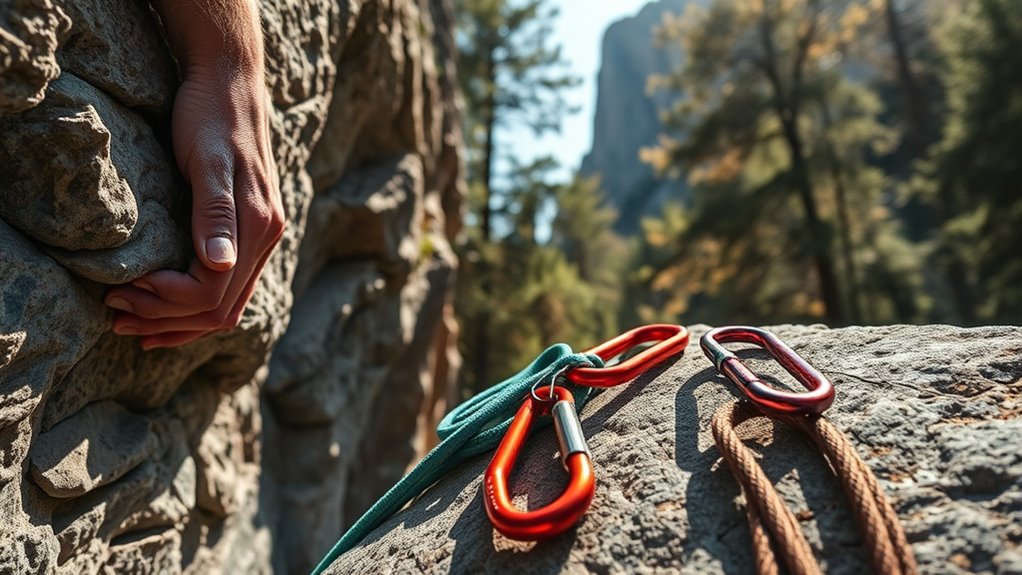Rock climbing combines essential gear knowledge and grip techniques for successful ascents. You’ll need to familiarize yourself with different climbing holds, like crimps and jugs, and understand how they impact your body mechanics. Mastering belaying techniques is vital for safety, ensuring clear communication with your climbing partner. As you develop your skills, you’ll build confidence and efficiency. Keep exploring and you’ll uncover even more tips to enhance your climbing experience.
Key Takeaways
- Understanding different climbing holds, such as crimps and jugs, is essential for effective grip techniques and overall climbing performance.
- Proper body mechanics and footwork complement hand holds, enhancing balance and efficiency during climbs.
- Mastering belaying techniques ensures climber safety, including smooth rope management and effective communication with your climbing partner.
- Regular practice and focus on grip and body movements help develop essential climbing skills and boost confidence.
- Familiarity with safety techniques is crucial for minimizing risks and enhancing the overall climbing experience.

Have you ever wondered what it takes to conquer a rock face? The thrill of scaling a vertical expanse is exhilarating, but it requires more than just physical strength; it demands skill, knowledge, and the right gear. Before you even start dreaming about reaching the summit, you’ll need to familiarize yourself with some climbing basics, including climbing holds and belaying techniques.
First off, let’s talk about climbing holds. These are the key elements that allow you to ascend. You’ll encounter different types, such as crimps, slopers, jugs, and pinches, each designed to challenge your grip in a unique way. Crimps are small, edge-like holds that require you to use your fingertips, while jugs provide a generous grip that lets you rest your whole hand. Understanding how to use these holds effectively can substantially enhance your climbing experience. You’ll find that your body positioning and footwork play a pivotal role in maximizing your grip and maintaining balance.
Climbing holds are essential for ascent, each type offering unique challenges that enhance your grip and balance.
Now, onto belaying techniques, which are vital for your safety and that of your climbing partner. When you belay, you’re essentially managing the rope to ensure that if your partner falls, they won’t plummet to the ground. You’ll need to learn how to handle the belay device properly. This involves feeding the rope smoothly and locking it off when necessary. A well-practiced belayer can make all the difference in a climbing session, providing the support needed to tackle challenging routes. It’s essential to communicate clearly with your climbing partner about commands, so you both know when to climb and when to lower.
Getting comfortable with climbing holds and mastering belaying techniques will elevate your climbing skills. You’ll develop a rhythm and confidence that empowers you to tackle more advanced routes. As you practice, pay attention to your body’s movements and how you interact with the rock. Each ascent offers a new lesson, whether it’s about your grip or your belaying finesse. Additionally, understanding the importance of climbing safety techniques can greatly enhance your overall climbing experience.
Frequently Asked Questions
What Should I Do if I Encounter Bad Weather While Climbing?
If you encounter bad weather while climbing, prioritize your safety. Seek shelter immediately and assess the situation. Monitor the weather conditions and have a plan for emergencies. Always carry a first aid kit and a means of communication. If you’re on a route, consider descending if it’s safe to do so. Stay calm, and remember that weather safety is vital; being prepared can make a significant difference in your experience.
How Can I Improve My Climbing Endurance?
To improve your climbing endurance, try incorporating interval training into your routine. For instance, if you climb for 20 minutes, rest for 5, then repeat this cycle. This method builds climbing stamina effectively. Additionally, focus on endurance training like long, steady climbs at a moderate grade to enhance your aerobic capacity. Remember, consistency is key; aim for several sessions a week to see significant improvements in your climbing endurance.
What Are Common Injuries in Rock Climbing?
Common injuries in rock climbing include climber’s fatigue and finger injuries. As you push your limits, fatigue can set in, leading to poor technique and increased risk of falls. Finger injuries often occur from over-gripping or sudden falls, straining tendons and ligaments. To avoid these issues, focus on building endurance gradually and incorporate finger-strengthening exercises into your routine. Always listen to your body to prevent injuries and guarantee a longer climbing journey.
How Do I Choose a Climbing Gym?
You’ve got to climb before you conquer! To choose a climbing gym, look for one that offers a variety of routes and training options. Check the quality of their climbing shoes and make certain they have a good selection available for rent or purchase. Also, make sure the harness fit is comfortable and secure. Finally, visit during peak hours to gauge the atmosphere and community vibe—it’s essential for your climbing experience!
What Nutrition Is Best for Climbers?
For climbers, a balanced climbing diet is essential. Focus on whole foods like lean proteins, complex carbs, and healthy fats. Incorporate fruits and veggies for vitamins and minerals, and don’t forget to stay hydrated. Nutrition tips include fueling your body before and after climbs with snacks like nuts or energy bars. Remember to listen to your body’s needs and adjust your meals accordingly to maintain energy and endurance during your climbs.
Conclusion
As you gear up and perfect your grip, remember that rock climbing isn’t just about reaching the summit; it’s about the journey up the wall. Each ascent teaches resilience, patience, and trust in yourself. Like a sturdy rope, these lessons will anchor you in life’s challenges. So, embrace the climb, celebrate every hold you conquer, and let each step inspire you to tackle new heights, both on the rock and beyond. Keep climbing; the view’s worth it!










